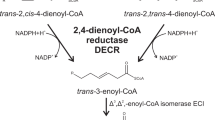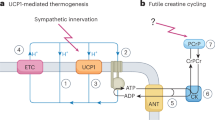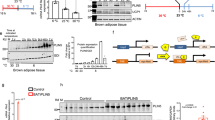Abstract
OBJECTIVE: To examine the possible involvement of an increase in diet-induced thermogenesis from brown adipose tissue (BAT) in the n-3 polyunsaturated fatty acids (n-3 PUFA) induced limitation of the development of white fat pads during high-fat feeding. DESIGN: Rats fed for four weeks on a low-fat/high-carbohydrate diet (C group) or high-fat diet without n-3 PUFA (REF group), with eicosapentaenoic acid (EPA group), with docosahexaenoic acid (DHA group) or with a mixture of these two fatty acids (MIX group). MEASUREMENTS: Epididymal and retroperitoneal fat pad mass, BAT composition, Guanosine 5’-diphosphate (GDP) binding and uncoupling protein (UCP) content were measured in the five groups of rats. RESULTS: The masses of retroperitoneal and epididymal white fat pads were lower in the groups fed n-3 PUFA than in the C and REF groups. The total BAT GDP binding was 1.6 times higher in the MIX and EPA groups than in the REF group. The BAT from the EPA group presented an enrichment in mitochondria compared to the C and REF groups whereas the BAT from the DHA and REF groups presented a hyperplasia and an increase in thermogenic activity of the mitochondria compared to the C group. The higher thermogenic activity of BAT was observed in the MIX group and is due to hyperplasia and to an increase in thermogenic activity of mitochondria. CONCLUSIONS: n-3 PUFA induce a marked stimulation of BAT thermogenic activity without changes in the UCP content compared to a high-fat diet without n-3 PUFA. The mixture of EPA and DHA has the more pronounced effect while EPA and DHA seem to act in synergy on BAT thermogenesis via different mechanisms.
This is a preview of subscription content, access via your institution
Access options
Subscribe to this journal
Receive 12 print issues and online access
$259.00 per year
only $21.58 per issue
Buy this article
- Purchase on Springer Link
- Instant access to full article PDF
Prices may be subject to local taxes which are calculated during checkout
Similar content being viewed by others
Author information
Authors and Affiliations
Rights and permissions
About this article
Cite this article
Oudart, H., Groscolas, R., Calgari, C. et al. Brown fat thermogenesis in rats fed high-fat diets enriched with n-3 polyunsaturated fatty acids. Int J Obes 21, 955–962 (1997). https://doi.org/10.1038/sj.ijo.0800500
Received:
Revised:
Accepted:
Issue Date:
DOI: https://doi.org/10.1038/sj.ijo.0800500
Keywords
This article is cited by
-
Omega 3 fatty acids stimulate thermogenesis during torpor in the Arctic Ground Squirrel
Scientific Reports (2021)
-
Omega-3 fatty acids as regulators of brown/beige adipose tissue: from mechanisms to therapeutic potential
Journal of Physiology and Biochemistry (2020)
-
Nutritional and non-nutritional agents that stimulate white adipose tissue browning
Reviews in Endocrine and Metabolic Disorders (2019)
-
Involvement of thermosensitive TRP channels in energy metabolism
The Journal of Physiological Sciences (2017)
-
The lipid sensor GPR120 promotes brown fat activation and FGF21 release from adipocytes
Nature Communications (2016)



